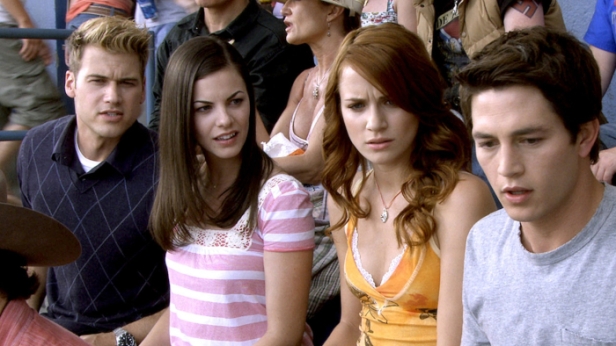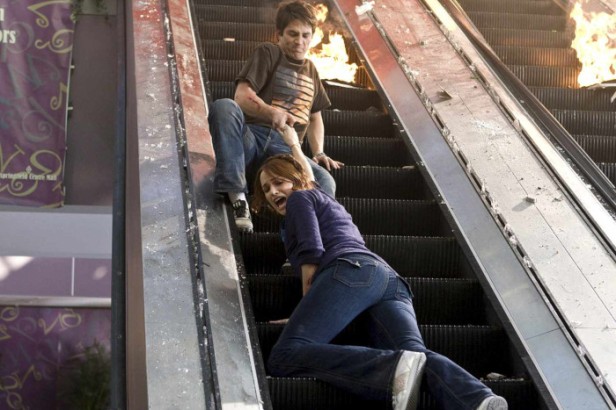Four instalments in and David R. Ellis, director of Final Destination 2 (2003), and Eric Bress, the writer of that earlier outing, returned to the fold, bringing with them the annoying habit of sequels/prequels/remakes using the same title (or, as here, very minor variations on it), instead of just continuing the number sequence from previous films. They also brought along an ironic end titles song (something we were going to hear a lot more of in the coming years) and most noticeably 3D, a newly revitalised gimmick thanks to the efforts of James Cameron whose Avatar (2009) was widely being touted as the film that would show everyone exactly how the format should be done (he did, but at the expense of minor irritations like plot and characters…) And with the Final Destination formula already milked dry, The Final Destination was going to need all the help it could get.
It’s 2009 and Death and whatever its opposite number is are up to their old tricks again. College student Nick O’Bannon (Bobby Campo) – yes those bloody in-jokey character names are back – attends a car race at the McKinley Speedway with his girlfriend Lori Milligan (Shantel VanSanten) (a Final Destination character seemingly named after Andy Milligan – whoever would have thought it?!) and their friends Hunt Wynorski (Nick Zano) and Janet Cunningham (Haley Webb). Nick is the recipient of the premonition this time, foreseeing a catastrophic pile up on the track that kills not only the racers but several spectators too. Nick panics and causes a fight, allowing him, Lori, Hunt, Janet, racist redneck Carter Daniels (Justin Welborn), mother Samantha Lane (Krista Allen), mechanic Andy Kewzer (Andrew Fiscella), his girlfriend Nadia Monroy (Stephanie Honoré), and security guard George Lanter (Myketti Williamson) to escape the stadium and the disaster. The usual series of deaths occur as Death tries to balance the books – Daniels is dragged to his demise by his own truck which then explodes; Samantha is killed when a rock launched by a passing lawnmower hits her in the eye; Andy is killed when a carbon dioxide tank fires itself at him; Janet is trapped in a malfunctioning car wash, but is rescued; and Hunt is disembowelled by a swimming pool drainage outlet. Nick has further premonitions of other survivors dying in an exploding cinema and by falling bathtub, as he and his dwindling group race to stay one step ahead once again of Death.

It wasn’t just the racing cars that the wheels were coming off – the whole Final Destination franchise was now looking a bit broken down and no amount of wheels, sharp implements or CGI blood being thrown into our faces was going to help. As proof, just watch the film “flat” and it’s revealed to be a very routine gore film in which even the usually outrageous death scenes feel rote and lacking in surprise. The effects are largely sub-par and the film has a cheap and threadbare feel to it compare o what had gone before.
Bress doesn’t help matters by making many of his characters intolerable jerks, so we really don’t have any emotional investment in them at all. They’re merely chess pieces to be moved into harm’s way as and when another death scene is required. The characters in the previous films weren’t exactly the most rounded or well developed of characters but this lot are so thin you’d be hard-pressed to remember a thing about them once the end credits have rolled. There’s an obnoxious jock hoping for a crash at the motor race and a racist redneck but the rest are just standard issue slasher fodder with quirks and tics in lieu of actual personalities.

There are one or two moments that impress – the racist scumbag dies in a failed attempt to leave a burning cross on the lawn of the black security guard who he blames for not saving his wife at the race track; the appalling jock lifeguard gets sucked arse first into a swimming pool outlet pipe; and there’s a witty moment wherein characters in a 3D film go to a cinema to watch a 3D film, but that’s about it really. Nothing else here is particularly memorable. Earlier films are namechecked, including an entirely unexplained roadside advert for Clear Rivers Water, senselessly referencing the heroine of the first two films for no reason other than to make fans giggle and nudge each other knowingly.
It’s such an unoriginal outing that it runs out of ideas for killing off its cast and just swipes the variation on the Lewton Bus gag from the first film and lifts the idea of X-ray imagery revealing internal injuries during violent death scenes from the altogether more fun Lik Wong/The Story of Ricky (1991). And yet it was inexplicably popular again, pocketing in excess of $187 million against a budget of just $40 million. Reviews were damning and it’s entirely possible that audiences were just turning up due to “brand recognition” and some odd sense of duty but not particularly enjoying the film (for what it’s worth, those surveyed by CinemaScore rated it a ‘C’ on their scale of A+ to F, marginally down from the B- for the first film, B+ for 2 and 3).

The Final Destination should have seen the franchise hitting a brick wall and coming to an ignominious end, but its box office success persuaded the suits at New Line (who presumably didn’t care one jot about those falling CinemaScore ratings) that it had one more outing in it. For once, we have to thank their dogged persistence as the next film, Final Destination 5 (2011) was a definite step back in the right direction. As for the hopeless The Final Destination, the best that might said for it is that at least it’s mercifully short…